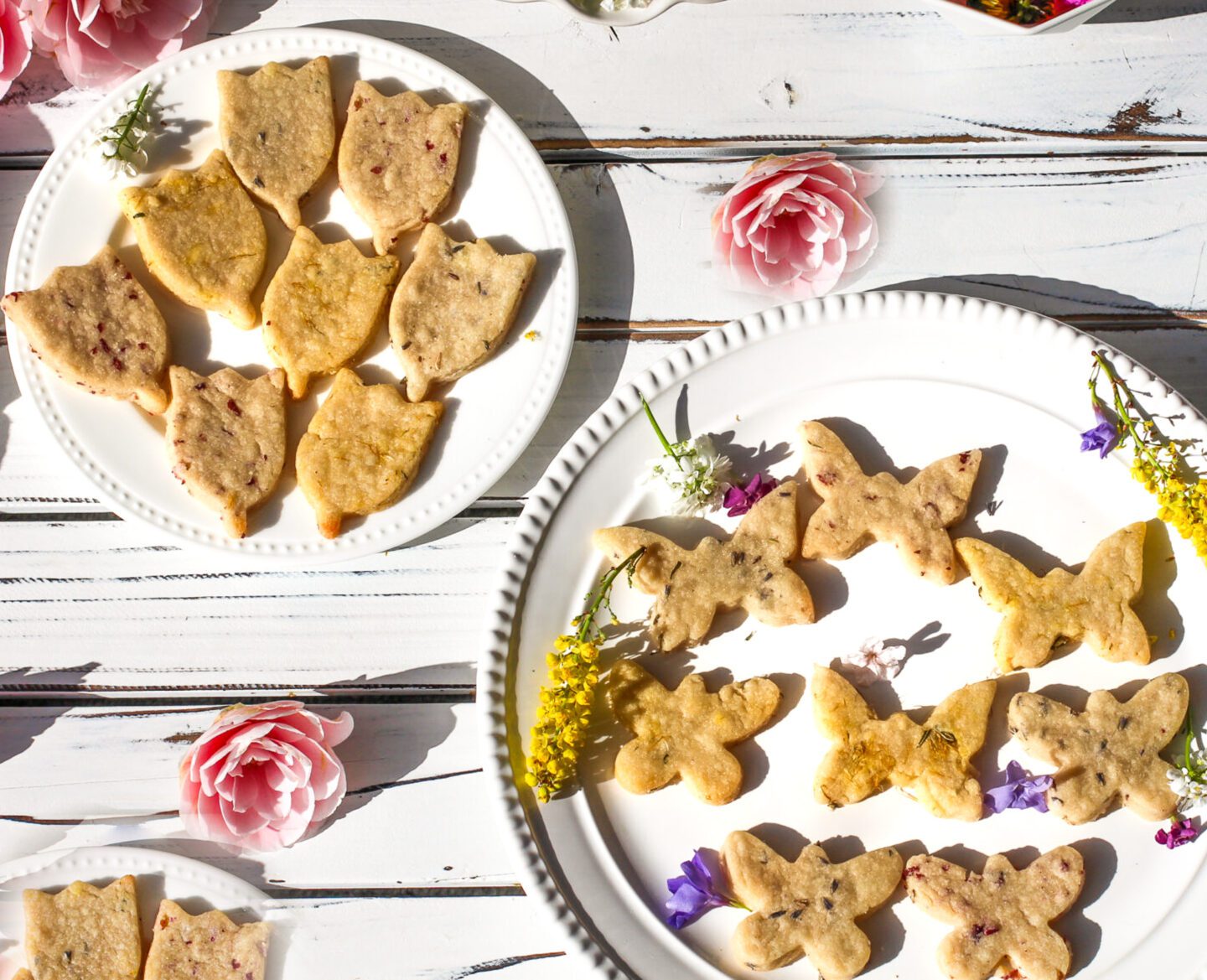
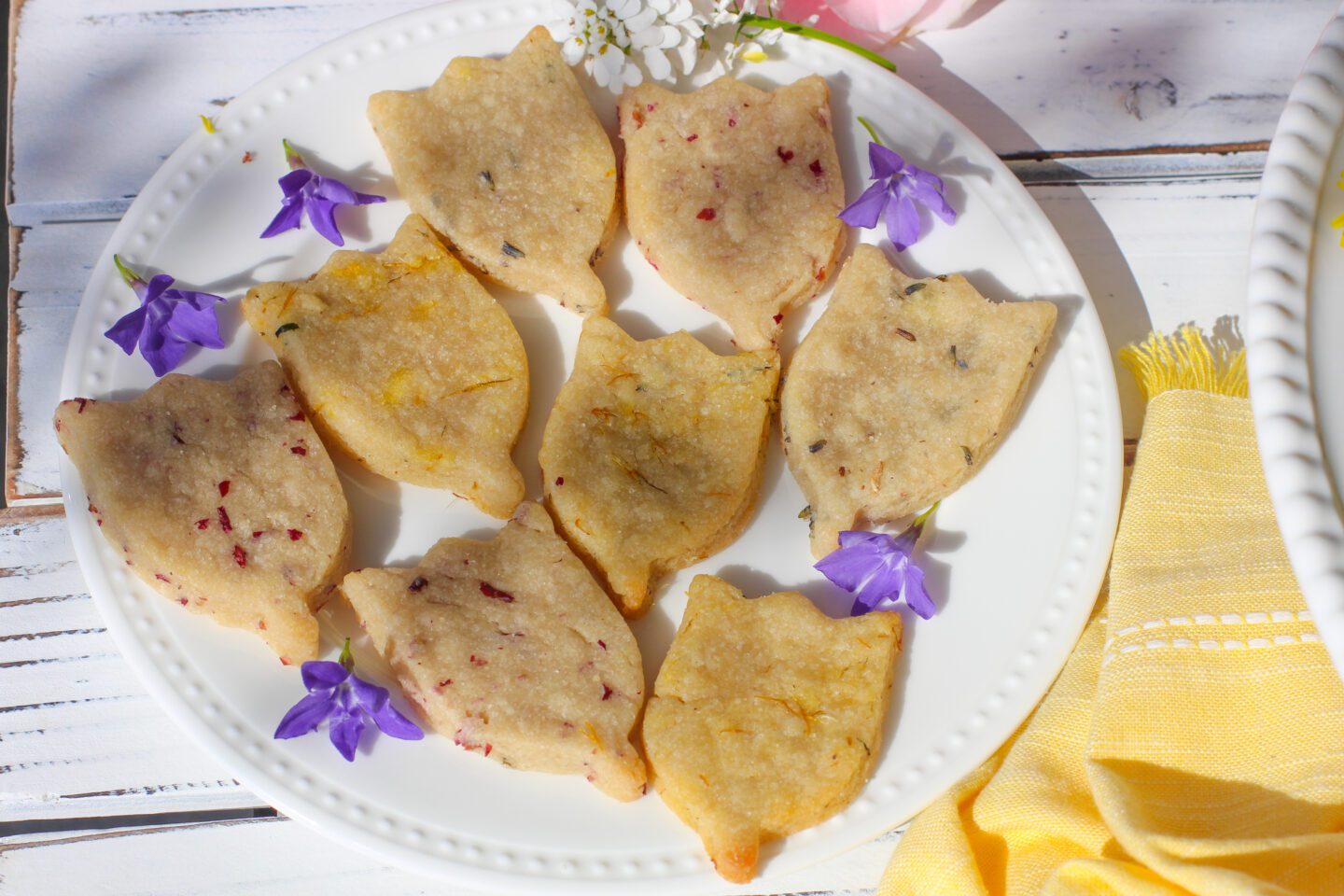
These Vegan Sugar Cookies feature pretty flecks of edible flowers inside a sweet, soft buttery cookie. Beautiful spring flowers are the stars in these cookies cut into spring shapes like butterflies and flowers. They are surprisingly simple to make and this no-fail recipe means the whole family can join in!
Keep reading for an A-Z list of edible flowers. Who knows? You may have some flowers in your garden or backyard you didn’t even know you could eat.
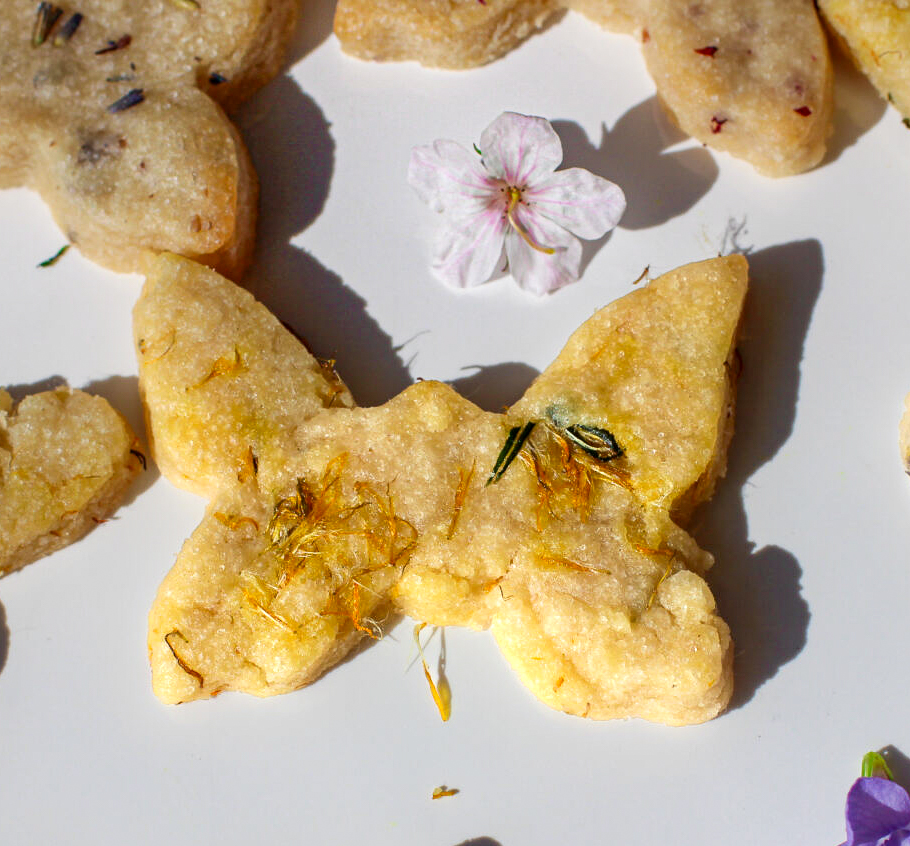
What Type Of Flowers To Use In This Recipe?
In this Spring Flower Vegan Sugar Cookie recipe, I use fresh dandelions, dried rose petals and lavender. You can use the same flowers I did or choose your edible flowers from the list below or purchase them on Amazon here.
Note: I make a very small commission, at no cost to you, for anything purchased through my site. Thank you in advance.
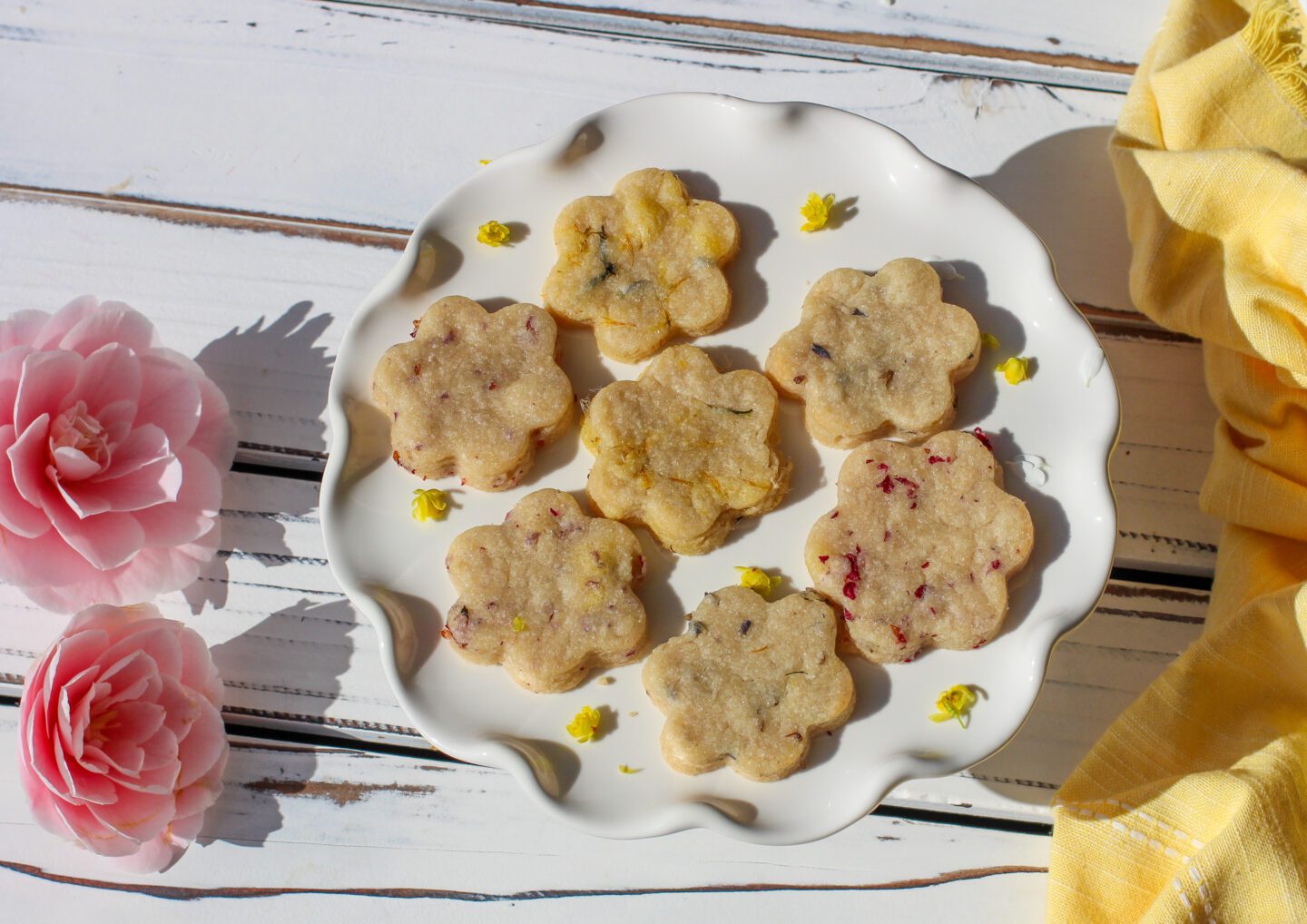
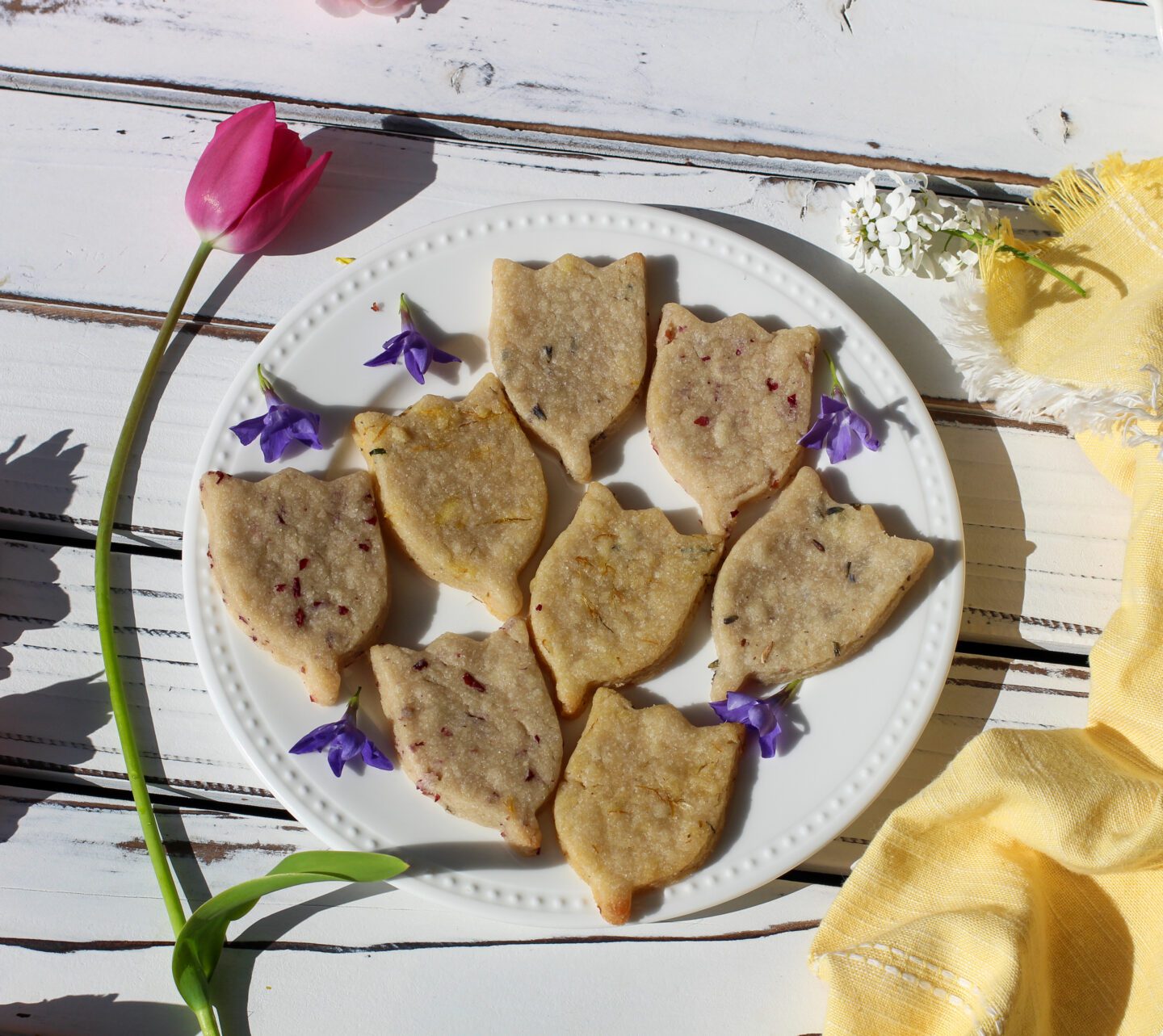
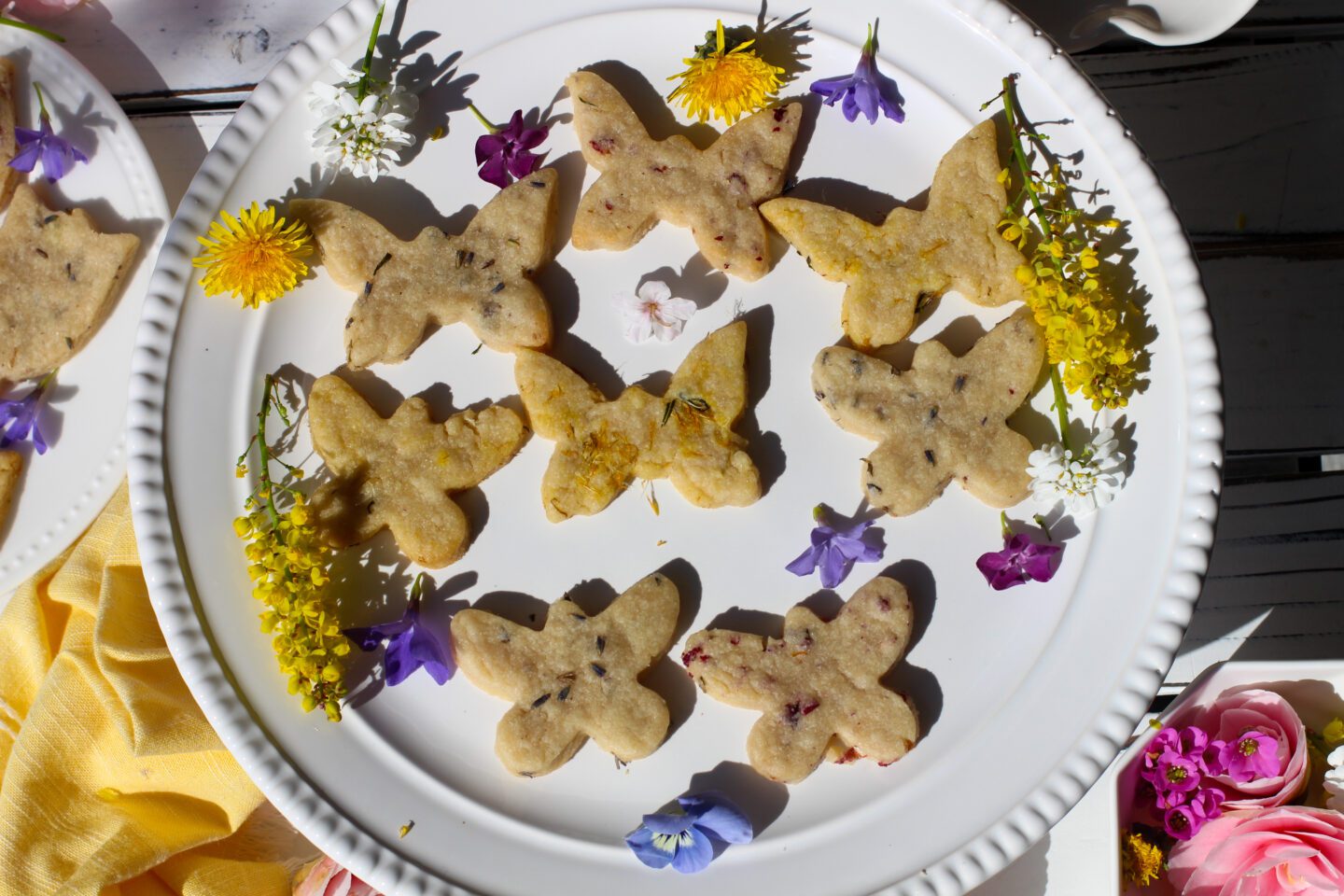
How To Properly Remove Dandelion Petals
Hold the flowers by the tip with the finger of one hand and pinch the green flower base very hard with the other, releasing the yellow florets from the base. Shake the yellow flowers into a bowl.
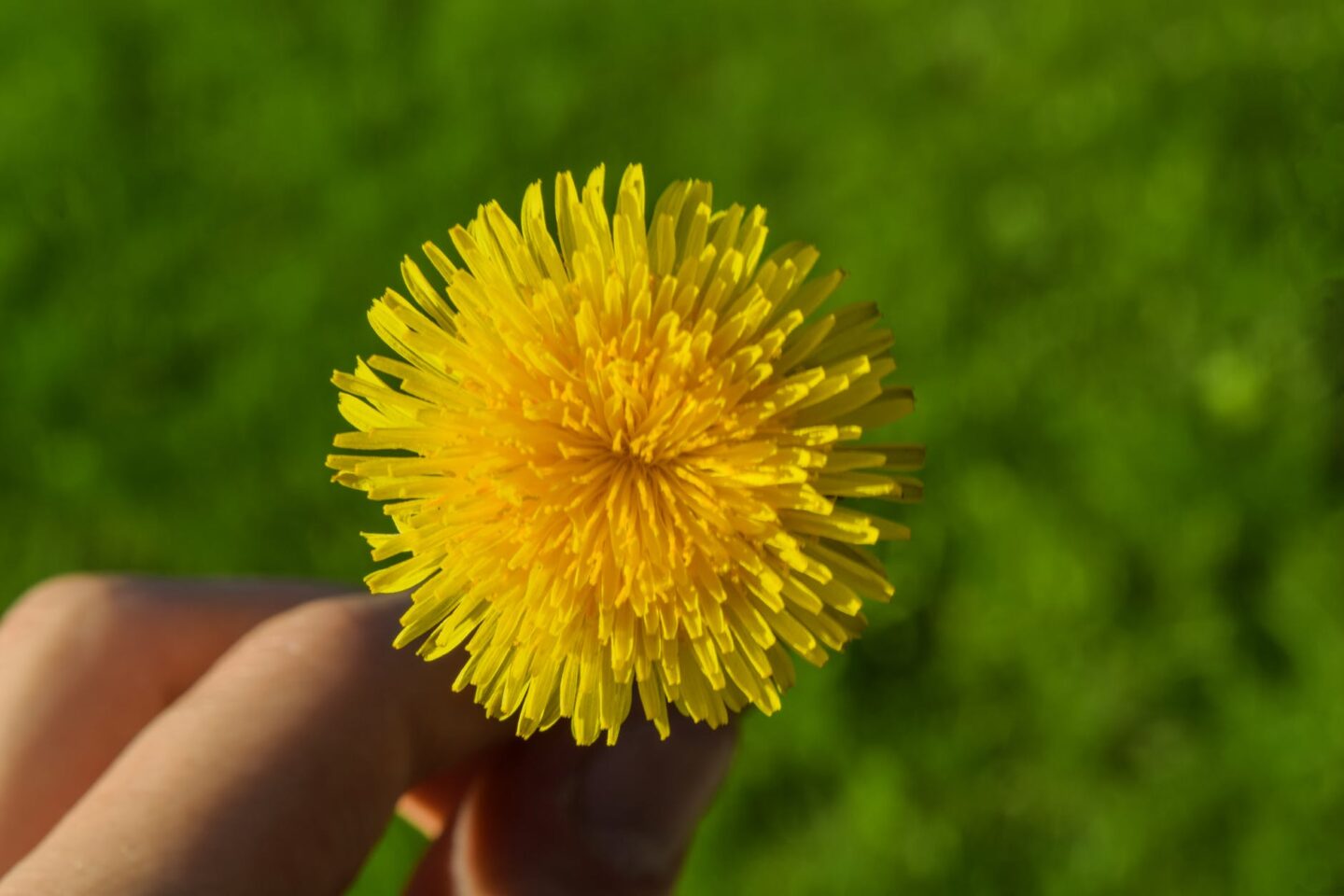
Make Sure Your Flowers Are Culinary-grade
Many varieties of flowers are edible. You’ll want to be certain the ones you are using are culinary-grade. Culinary grade means they’re been grown and packed in conditions that are food-safe and free of potentially harmful chemicals. You can order edible flowers from some florists or grocery stores, online, or pick them from your garden like I did. When I don’t have access to fresh organic edible flowers I get them dried. You can buy the ones I use here on Amazon.
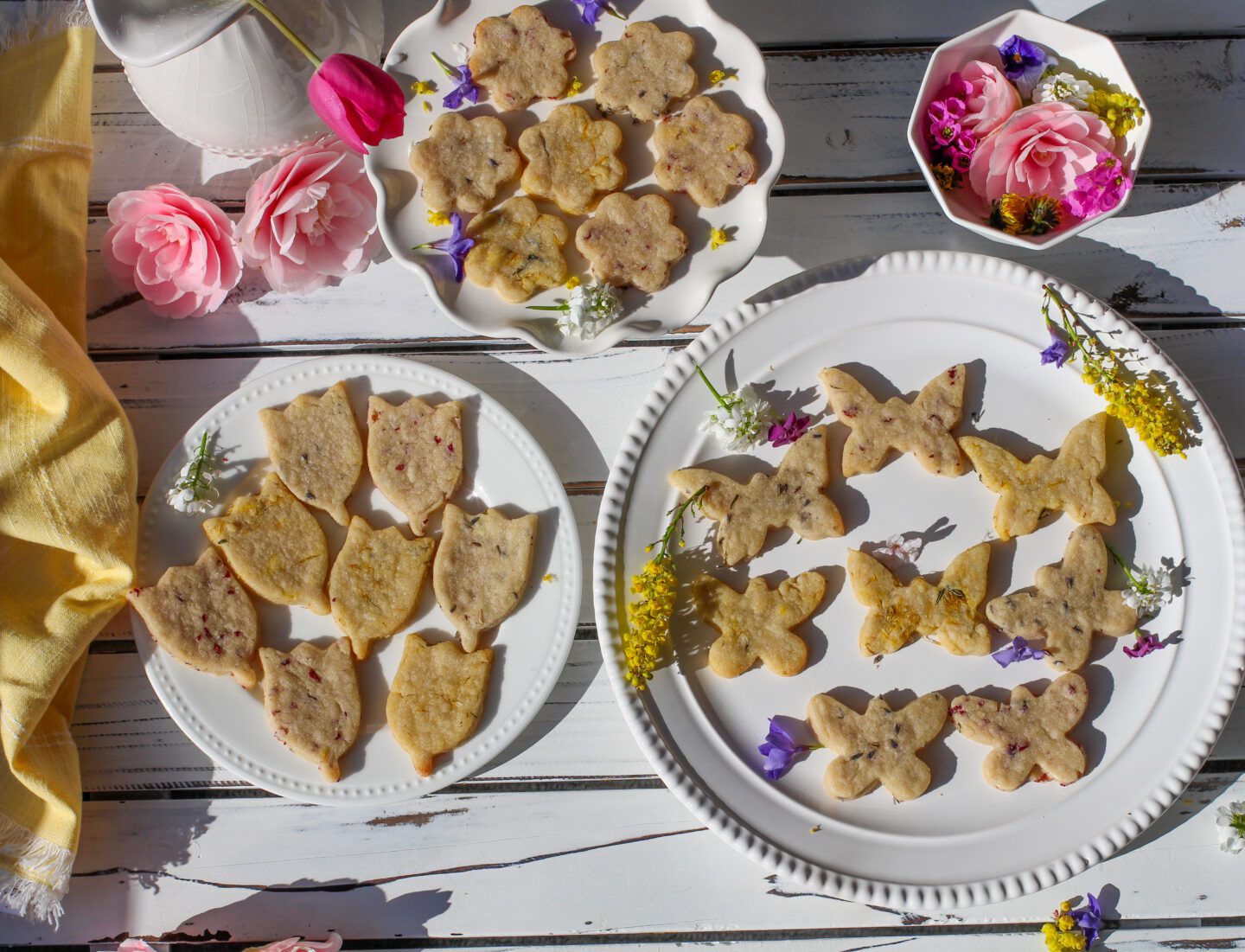
List Of Edible Flowers From A-Z
Have fun with these Spring Flower Vegan Sugar Cookies by trying out different flowers or herbs. Below is a list of edible flowers with some other recommendations for how to use them.
A
- Angelica: This herb has lacy white flowers and tender stems. Angelica’s taste resembles celery. Use angelica in salads or to garnish fish and soup.
- Anise Hyssop: Use the flowers and leaves of this plant to give food a slight licorice, or anise flavor. Use in salads, as a garnish or in Chinese cuisine.
- Apple: The delicate, floral flavor of apple blossoms complements light spring desserts. Use moderation, though, as the blossoms may contain cyanide precursors.
- Arugula: Sometimes called garden rocket, arugula is commonly grown as a salad green. It produces yellowish or white flowers that add a peppery flavor to salads.
B
- Basil: This common garden herb produces small clusters of white flowers that may have a mint, chocolate, or traditional basil flavor, depending on the variety.
- Bee Balm: This perennial plant produces clusters of tube-like flowers. The flowers are often used dried as a replacement for bergamot tea, and have a mild citrus flavor.
- Borage: The flowers of this mint-like plant are usually blue, but may also be pink or white. They have a refreshing cucumber taste that pairs well with canapés and salads.
- Broccoli: As broccoli heads mature, they open up to reveal tiny yellow flowers. Pinch the flowers back to encourage more growth, or use the slightly spicy flowers in salads and cooked dishes.
C
- Chrysanthemum: Blanche the petals and sprinkle them over salads, soups and sauces for a spicy, peppery taste. Avoid the flower base, which is bitter and difficult to digest.
- Calendula: The dried flowers of calendula are sometimes referred to as “poor man’s saffron.” Use this plant to add a spicy, peppery taste to food.
- Carnation: Add small pesticide-free carnations to salads for a peppery taste, or place whole flowers on cakes and desserts as a garnish.
- Chamomile: The yellow or white daisy-like petals of chamomile have been used for centuries to make a soothing herbal tea. Use the petals only. Some people may experience an allergic reaction to chamomile.
- Chervil: Use the white flowers of chervil in salads or main dishes to impart a mild licorice taste. Add the flowers right before serving and don’t heat them, which dilutes the flavor.
- Chicory: Chicory grows wild in many parts of the United States. The blue flowers add a peppery taste to salads; pickle the buds as you would capers.
- Chives: Add the small purple flowers of chives to salads for a mild, onion flavor. The flowers emerge in mid-spring.
- Cilantro: The leaves are more commonly used, but try the flowers for a fresh, herbal taste. Some people find the taste of cilantro soapy and unpleasant, others can’t get enough of it. Use it in Mexican dishes.
- Cornflower: Also known as bachelor’s button, these small pom pom shaped flowers make charming garnishes. The flowers are usually blue and have a sweet or spicy taste.
D
- Dandelion: Served fresh in salads, dandelion have a slightly sweet or peppery taste. When cooked in butter, they take on a taste similar to mushrooms. Buds or young flowers taste the best. Mature flowers tend to be bitter.
- Day Lily: Eat day lily blooms in moderation because they may have a laxative effect. Avoid other lilies, which may be toxic. Day lilies have a faint vegetable taste that has been compared to lettuce or beans.
- Dill: Use the flowers and leaves to flavor salads, soups and sauces. Dill has a tangy, warm, aromatic flavor and dries well.
E
- Elderberry: Elderberries grow wild in the Pacific Northwest and parts of the Midwest and New England and may also be cultivated. The creamy blossoms of these plants have a sweet fragrance and taste. Use them to garnish desserts, but do not wash them, because doing so removes most of the flavor. The roots and leaves of this plant are toxic. Raw berries may also cause illness.
- English daisy: These cheerful flowers have a spicy, slightly bitter taste and are best used as a garnish. Eat the petals only.
F
- Fennel: Fennel has a mild anise taste that improves when it is cooked. Use the star-shaped yellow flowers in salads and sauces.
- Fuschia: The unique shape and bright colors of fuschia make them an eye-popping garnish for desserts and fruit trays. The fruits are edible, as well.
G
- Garden sorrel: Garden or French sorrel is an easy to grow salad green, but allow it to go to flower and you have a lovely, lemon-flavored garnish or addition to salads, sauces, desserts and main dishes.
- Garlic: Like chives, garlic produces purple flowers in mid-to-late spring. Add the flowers to salads for a mild, garlic flavor.
- Ginger: Use the petals in salads and desserts to add a spicy, mild ginger flavor. Eat ginger raw or cooked in stir fries and soups.
- Gladiolus: Fill gladiolus flowers with mousse for an interesting presentation, or mix individual petals in salads. Gladiolus have a bland taste resembling lettuce.
H
- Hibiscus: Hibiscus has a tart, slightly bitter taste and is generally used dry as a base for herbal teas. The dried flowers add color, as well as flavor to teas.
- Hollyhock: Hollyhocks make charming garnishes, but the flowers lack flavor and texture. Use them decoratively instead.
- Honeysuckle: Children have long known the pleasure of sucking the nectar out of these white and gold flowers. Honeysuckle has a sweet flavor, but avoid the berries, which are poisonous.
I
- Impatiens: These fragile, annual flowers have a sweet flavor well-suited to drinks or desserts. Float them in a punch bowl for instant color or freeze them in ice cubes.
J
- Jasmine: Use true jasmine to flavor teas with its sweet scent, but beware of false jasmine, also known as woodbine, yellow jasmine or Jessamine, trumpetflower or Carolina jasmine. This plant is not related to jasmine and is toxic. True jasmine produces waxy, white flowers and shiny oval leaves.
KL
- Lavender: Lavender is used dried in baked goods, but may also be used fresh to add a light, citrus or floral taste to champagne or desserts. Do not use lavender oil unless it is food-safe.
- Lemon flowers: Use these waxy, fragrant flowers as garnishes, but eat them sparingly. Use untreated lemon leaves as a base for canapés or desserts.
- Lemon Verbena: Lemon verbena is a woody herb that produces leaves with a strong citrus scent. Use the small, creamy flowers to add a citrus flavor to iced teas, lemonade, sauces or desserts.
- Lilac: The taste of lilac varies depending on the type. Most lilacs have a slightly bitter, lemony taste. Use them to decorate desserts.
MN
- Marigold: Add the cheery flowers of marigolds to salads for a bright color and slightly peppery flavor. Marigolds grow easily in almost any condition.
- Marjoram: Use the small, white flowers of this flavorful herb as you would the leaves. Add the mild tasting flowers to salads and sauces.
- Mint: Mint flowers have a minty taste, but may also have chocolate, lemon or apple undertones, depending on the variety. Use mint in tea or lemonade or in Greek salads.
O
- Okra: This odd looking, thorny vegetable produces hibiscus-like flowers. Saute or fry them for an exotic treat.
- Orange flowers: Use these as you would lemon flowers, sparingly, and as a garnish. Flavor water by soaking the blooms.
- Oregano: The tiny white flowers of this herb have a milder taste than the leaves. Use them in Italian dishes, salads.
P
- Pea Blossom: Snap peas, snow peas and English peas all produce white, or occasionally pink, blossoms. The blossoms are sweet, tender and delicious in salads. Eating the blossoms will diminish your harvest so plan accordingly.
QR
- Rosemary: Treat this perennial herb as an annual in cold climates. Use the flowers to flavor salads.
S
- Safflower: The dried, yellow leaves of this plant’s flowers are used as Mexican saffron. This spice has a milder flavor than Spanish saffron and is used primarily as a coloring.
- Sage: The gray-green leaves of sage are traditionally used in stuffings and to flavor. The delicate blue, white or pink flowers have a mild flavor and are good in salads.
- Summer Squash: Use the first tender blossoms of yellow summer squash or zucchini. These flowers are males and won’t produce fruit. Identify the females by the small bump that forms at the base of the flower. Stuff, fry or bake summer squash blossoms for a sumptuous feast.
TUVWXYZ
- Viola: Also known as Johnny Jump-Ups, these tiny purple, yellow and blue flowers have a mild, wintergreen flavor. Use them decoratively on cakes and desserts, add them to salads or float them in drinks.
Source: Gardening Channel
IMPORTANT CONSIDERATIONS:
BEFORE CONSUMING ANY PLANT OR FLOWER, CHECK WITH A MEDICAL OR PLANT PROFESSIONAL.
NOT EVERY FLOWER/PLANT IS EDIBLE – In fact, sampling some flowers can make you very, very sick.
-You also should NEVER use pesticides or other chemicals on any part of any plant that produces blossoms you plan to eat.
-Never harvest flowers growing by the roadside.
-Identify the flower exactly and eat only edible flowers and edible parts of those flowers.
-Always remember to use flowers sparingly in your recipes due to the digestive complications that can occur with a large consumption rate.
This Spring Flower Vegan Sugar Cookies Recipe Is Fool-Proof
If you’ve been following Susan Cooks Vegan for a while you will remember my popular past recipe Dandelion Vegan Shortbread Cookies. If you’ve made shortbread before you know how temperamental it can be. That why I created this Spring Flower Vegan Sugar Cookies recipe. I wanted a fun flower recipe that was more forgiving than shortbread.
I first made these sugar cookies with Stacie Bennett from Sugar Love Designs. I took one of her super fun cookie decorating classes (I would highly recommend them) where she shared this recipe. I have altered it slightly adding some salt and more vanilla but the base recipe is hers.
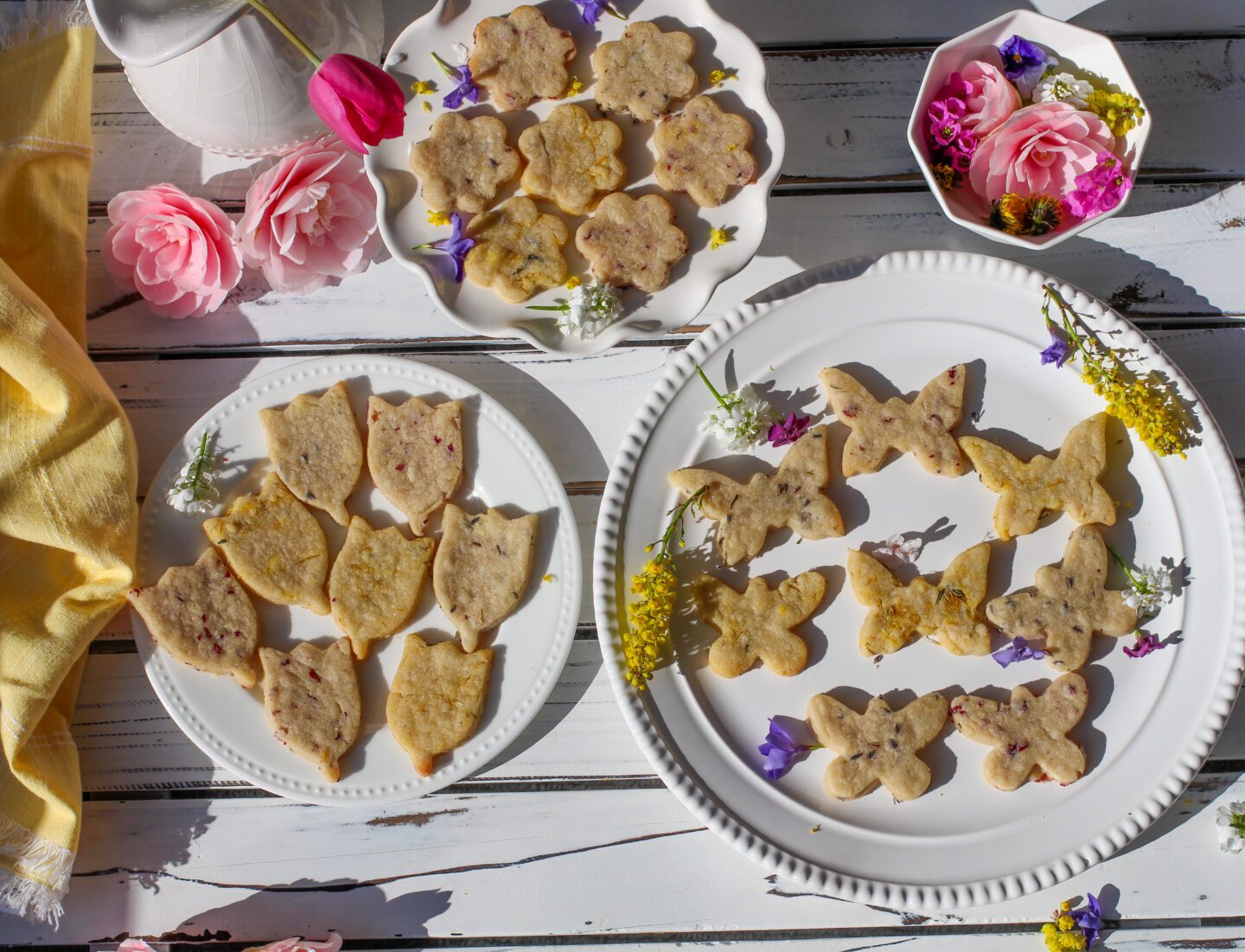
What If I Don’t Want To Use Flowers In This Recipe?
If you don’t want to use flowers in this recipe or you want to make plain vegan sugar cookies to decorate for a special occasion, no problem. Simply omit the flowers. If you are looking to decorate your vegan sugar cookies you can order supplies from Sugar Love.
More Cookie Recipes To Try
If you love this Spring Flower Vegan Sugar Cookies recipe as much as I do you are going to want to my other cookie recipes:
–World’s Best Vegan Chocolate Chip Cookies
–Orange and Ginger Stained Glass Cookies
Sharing Is Caring!
When you make your first batch (or your twelfth) of Spring Flower Vegan Sugar Cookies share them with me at @SusanCooksVegan on YouTube, Instagram, Facebook , Pinterest and Twitter. I’ll feature your beautiful creations on my Instagram and Facebook stories.
Don’t forget to leave a comment on the recipe below and give these cookies a star rating.
Thanks for the love, my friends!
Susan xox
PrintThe Best Vegan Sugar Cookies with Edible Flowers
Vegan Sugar Cookies feature pretty flecks of color inside a sweet, soft buttery cookie. No need for sprinkles or frosting. Beautiful spring flowers are the star of these cookies. They are surprisingly simple to make and this no-fail recipe means the whole family can join in!
- Prep Time: 10 minutes
- Cook Time: 10 minutes
- Total Time: 20 minutes
- Yield: 40–60 cookies (depending on size) 1x
- Category: Cookies
- Method: Baking
- Cuisine: Canadian, American
- Diet: Vegan
Ingredients
- 2 pounds (2 cups) plant butter, room temperature
- 2 cups vegan white sugar
- 2 tsp clear* vanilla extract
- 5 cups all-purpose flour
- 2 tbsps cornstarch
- 1 tsp baking powder
- 1/8 tsp salt
Edible Flowers*
- 1/2 cup dandelion petals (yellow parts only)
- 4 tbsp dried rose petals
- 4 tbsp dried lavender
*More or less to taste
Instructions
- Preheat oven to 350F. Line 2 baking sheets with silicone baking mats*
- Add plant butter to a large mixing bowl or stand mixer. Add sugar and cream together using the paddle attachment or mixing spoon. Mix in vanilla extract.
- Add flour (one cup at a time), corn starch, baking powder and salt. You want a smooth dough, in between crumbly and sticky. The dough should come together when squeezed in your hands. If it is too sticky the cookies will spread while baking.
- Divide the dough into three parts. Working with one piece at a time slowly sprinkle over flowers and knead in until evenly distributed.
- Flour a clean work surface or lay down a piece of parchment paper. Place a second piece on top to prevent sticking.
- Roll dough until about 1/3-1/2 inch thick. Cut into desired shapes. These are the spring cookie cutters I used. Place on prepared baking trays.
- Continue re-rolling the dough until it is all used. Bake in the oven for 8-10 minutes.
- Keep a close eye on them and remove just when the edges start to show a little color change. They will be soft when they come out of the oven, but firm as they cool. Be sure not to overbake them or they will be crispy. Allow to cool for 10 minutes before transferring to a cooling rack.
- Store refrigerated in an airtight container for up to 7 days or freeze for up to 6 months.
Notes
* Clear vanilla extract is preferred in this recipe to keep the cookies a lighter shade. If you cannot find clear, dark vanilla will work, however your cookies may be slightly beige.
* Silicon baking mats allow for even heat distribution. If you do not have silicon, parchment paper will work, however the cookies may spread slightly.


I made these cookies with my kids. The entire family loved them! The also made a nice hostess gift. Thanks for the recipe Susan 💗🌸🌷
Author
Thanks for the comment Kelly. Giving these cookies as a hostess gift is a great idea. Thanks for sharing. 🙏🏻💗🍪🌸🌹🌼